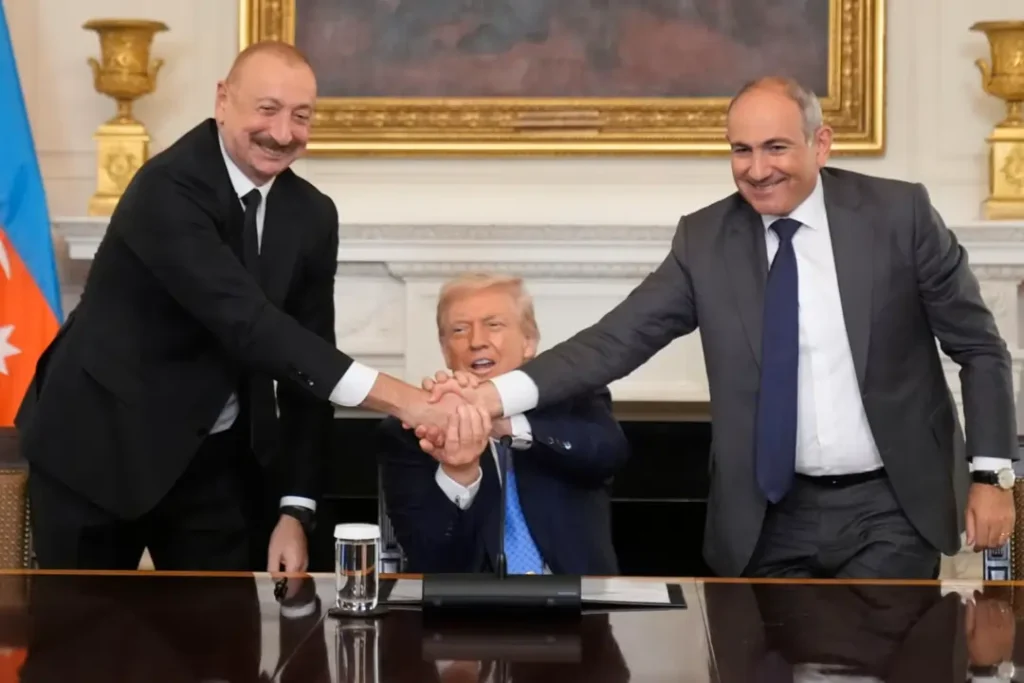New Delhi: In a landmark development for the South Caucasus, Armenia and Azerbaijan have reached a preliminary peace agreement brokered by the United States, aiming to resolve nearly four decades of hostility primarily centered on the Nagorno-Karabakh region. Signed at the White House on August 8, 2025, under the auspices of US President Donald Trump, the deal includes key provisions for cessation of hostilities, establishment of diplomatic relations, and the creation of a new transit route. This Armenia-Azerbaijan peace deal, hailed as a significant step toward regional stability, has sparked varied reactions from global powers, with Iran rejecting the planned corridor and Russia offering cautious support.
The agreement, initiated by the foreign ministers of both nations, pledges mutual respect for territorial integrity, renunciation of territorial claims, and a commitment to refrain from using force while adhering to international law. Azerbaijani President Ilham Aliyev and Armenian Prime Minister Nikol Pashinyan posed with their documents alongside President Trump during the trilateral signing event, captured in photos by Reuters photographer Kevin Lamarque. Although not yet formally signed, the text was published by both countries on August 11, 2025, marking a pivotal moment in the Armenia-Azerbaijan conflict timeline.

Key Provisions of the Armenia-Azerbaijan Peace Agreement
At the heart of the deal is the cessation of armed conflict, with both nations agreeing to end hostilities and foster diplomatic ties. A standout feature is the “Trump Route for International Peace and Prosperity” (TRIPP), a new transit corridor linking mainland Azerbaijan to its exclave of Nakhchivan through Armenian territory. The United States has been granted exclusive development rights for this route, which will operate under Armenian law and is expected to enhance energy exports and economic connectivity in the region.
Additionally, separate US cooperation deals were signed with Armenia and Azerbaijan to boost collaboration in energy, technology, and economic sectors. This US involvement underscores Washington’s growing leverage in the South Caucasus, a strategically vital area rich in oil and gas pipelines, neighboring Russia, Europe, Turkey, and Iran.
The deal explicitly prohibits the deployment of third-party forces along the shared border, potentially targeting previous Russian peacekeeping missions. This clause reflects ongoing tensions, as Azerbaijan has demanded the withdrawal of the European Union’s border monitoring mission, which observes ceasefire violations.
Historical Background of the Armenia-Azerbaijan Conflict
The roots of the Armenia-Azerbaijan conflict trace back to the late 1980s, when Nagorno-Karabakh, a mountainous enclave within Azerbaijan predominantly inhabited by ethnic Armenians, sought independence with Armenia’s backing. Following the Soviet Union’s collapse in 1991, both countries gained independence, but the dispute escalated into full-scale wars.
In the 1990s, Armenia supported Nagorno-Karabakh’s breakaway, leading to territorial gains. However, in 2023, Azerbaijan regained full control of the region in a swift military operation, prompting the exodus of nearly 100,000 ethnic Armenians to Armenia. This displacement highlighted the humanitarian toll of the conflict, which has hampered regional development due to closed borders and ethnic enmities.
Armenia last year returned several villages to Azerbaijan, described by Baku as a “long-awaited historic event.” Despite these steps, unresolved issues persist, including Azerbaijan’s demand for Armenia to amend its constitution, which Baku claims implicitly asserts territorial claims over Azerbaijani land. Armenian Prime Minister Pashinyan has proposed a referendum to revise the constitution, potentially in 2027, though no date is set, and the issue remains divisive among Armenians.
International Reactions to the US-Brokered Peace Deal
The Armenia-Azerbaijan peace agreement has elicited a spectrum of responses. India has expressed strong support, labeling it an “Important Achievement” for dialogue and diplomacy. For India, the deal holds strategic value: Armenia is its only regional partner with a Friendship and Cooperation Treaty signed in 1995, while Azerbaijan lies on the International North-South Transport Corridor, linking India to Russia via Central Asia.
Turkey, a NATO member and staunch ally of Azerbaijan, welcomed the accord, particularly the transit corridor. President Recep Tayyip Erdogan discussed the agreement with Aliyev, offering Ankara’s support for lasting peace. Turkish Foreign Minister Hakan Fidan, during a visit to Egypt, emphasized the corridor’s potential to connect Europe with Asia via Turkey, boosting energy and resource exports.
The European Union and NATO have praised the deal as a “significant step forward.” Azerbaijani analyst Ahmad Shahidov from the Azerbaijan Institute for Democracy and Human Rights told Al Jazeera that the US-brokered accord serves as a “roadmap” for a final peace declaration, expected in the coming weeks, with no remaining territorial disputes.
However, regional powers Iran and Russia have voiced concerns. Iran has outright rejected the planned transit corridor, vowing to block it “with or without Russia.” Ali Akbar Velayati, a top adviser to Iran’s supreme leader Ayatollah Ali Khamenei, criticized the initiative in state-affiliated Tasnim News, stating that Trump views the Caucasus as “a piece of real estate he can lease for 99 years.” Velayati described the corridor as “political treachery” undermining Armenia’s territorial integrity and warned it would become a “graveyard” for “Trump’s mercenaries.” He argued it could allow NATO to position itself “like a viper” between Iran and Russia.
Iran’s foreign ministry, while welcoming the peace deal, expressed worries about foreign intervention near its borders, insisting projects respect national sovereignty and territorial integrity without outside interference. This stance highlights Iran’s strategic alliance with Armenia and Russia, and its opposition to US presence along its northern frontier.
Russia, traditionally Armenia’s ally with a military base in the country, offered a cautious welcome. The Russian Ministry of Foreign Affairs supported regional stability efforts but warned against non-regional players creating divisions, drawing parallels to Western-led resolutions in the Middle East. Spokeswoman Maria Zakharova noted the need to analyze the corridor clause, referencing existing trilateral agreements between Russia, Armenia, and Azerbaijan. She emphasized that Armenia’s border with Iran is guarded by Russian border guards, underscoring Moscow’s lingering influence despite its focus on the Ukraine conflict since 2022.
Analysts suggest Russia’s waning role in the Caucasus stems from its Ukraine engagement, diverting resources and allowing Western powers like the US to step in. Independent analyst Olesya Vardanyan told AFP that the deal testifies to Russia’s lost influence, though it promises Armenians a “better life and more peace in the region.” The International Crisis Group’s senior South Caucasus analyst Joshua Kucera pointed out that much of the White House agreement repackages a March deal between Armenia and Azerbaijan, potentially to curry favor with Trump by giving him a prominent role.
Geopolitical Implications and Future Challenges
The fallout from this Armenia-Azerbaijan peace deal extends beyond bilateral relations, reshaping geopolitics in the energy-rich South Caucasus. The US’s exclusive rights to develop the TRIPP corridor provide Washington with business opportunities and leverage, potentially transforming trade routes and energy flows. Azerbaijani President Aliyev has even endorsed Trump’s nomination for the Nobel Peace Prize, reflecting Baku’s appreciation for US mediation.
Yet, uncertainties loom. The deal leaves questions unanswered, such as detailed corridor implementation and constitutional changes in Armenia. Kucera warned that missing specifics could become “serious stumbling blocks,” and the divisive constitutional referendum might derail progress.
Iran’s rejection signals potential for heightened tensions, as Tehran distances itself from Russia on this issue. Velayati’s remarks underscore fears of endangered South Caucasus security and foreign meddling. Meanwhile, Russia’s hesitation highlights its strained ties with Armenia, which has drifted westward amid Moscow’s non-intervention in recent conflicts.
In a broader context, the agreement follows failed talks, including a meeting in the UAE without breakthroughs and prior US-led discussions. Al Jazeera’s coverage questions how long before the corridor materializes and what Washington’s increased presence means for the region. Guests like Vasif Huseynov from the Center of Analysis of International Relations, Jamila Mammadova from the Henry Jackson Society, and political analyst Vahram Ter-Matevosyan have analyzed the implications, emphasizing the deal’s potential to slip the South Caucasus from Russia’s grasp.
Pashinyan described the agreement on Facebook as a “solid foundation for establishing a reliable and lasting peace,” balancing both countries’ interests. Aliyev, speaking in Washington, noted Armenia’s “homework” on constitutional amendments, after which the final signing could occur “at any time.”
India’s Strategic Interest in the Peace Accord
India’s endorsement aligns with its regional stakes. The Friendship and Cooperation Treaty with Armenia strengthens ties, while Azerbaijan’s position on the North-South Corridor facilitates India’s connectivity to Russia and Central Asia. This support underscores New Delhi’s preference for diplomatic resolutions in global hotspots.
As the world watches, the Armenia-Azerbaijan peace deal represents a hopeful yet fragile path forward. With images from the White House signing circulating widely—showing Trump at the center, flanked by Aliyev and Pashinyan—the accord could redefine the South Caucasus, provided regional powers navigate the ensuing geopolitical rift.
Frequently Asked Questions
1. What is the Armenia-Azerbaijan peace agreement signed on August 8, 2025?
The US-brokered peace deal between Armenia and Azerbaijan, signed at the White House, aims to end nearly four decades of conflict over Nagorno-Karabakh. It includes cessation of hostilities, establishment of diplomatic relations, and a transit corridor called the “Trump Route for International Peace and Prosperity” (TRIPP) linking Azerbaijan to its Nakhchivan exclave through Armenia, with exclusive US development rights.
2. Why is the Nagorno-Karabakh region central to the Armenia-Azerbaijan conflict?
Nagorno-Karabakh, a mountainous enclave within Azerbaijan but predominantly populated by ethnic Armenians, has been a flashpoint since the 1980s. It broke away from Azerbaijan with Armenia’s support, leading to wars after the Soviet Union’s collapse in 1991. Azerbaijan regained control in 2023, causing nearly 100,000 Armenians to flee, intensifying the need for a peace agreement.
3. Why has Iran rejected the planned transit corridor in the peace deal?
Iran opposes the TRIPP corridor, fearing it undermines Armenia’s sovereignty and allows NATO’s presence near its border. Ali Akbar Velayati, an adviser to Iran’s supreme leader, called it “political treachery” and vowed to block it, citing security risks and US interference in the South Caucasus.
4. How does the peace deal impact regional powers like Russia and Turkey?
Russia, Armenia’s traditional ally, cautiously welcomed the deal but warned against foreign meddling, reflecting its waning influence due to the Ukraine conflict. Turkey, a NATO member and Azerbaijan’s ally, supports the corridor, seeing it as a boost for energy exports and connectivity between Europe and Asia.
5. What role does India play in supporting the Armenia-Azerbaijan peace agreement?
India endorsed the deal as an “Important Achievement” for diplomacy. It values Armenia as a treaty partner since 1995 and Azerbaijan’s position on the North-South Transport Corridor, enhancing India’s connectivity to Russia and Central Asia, aligning with its strategic interests in regional stability.

